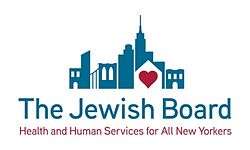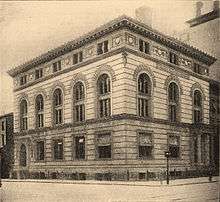Jewish Board of Family and Children's Services
 | |
| Headquarters | New York, New York |
|---|---|
CEO | David Rivel |
| Website | The Jewish Board |
The Jewish Board of Family and Children’s Services (The Jewish Board) is one of the United States' largest nonprofit mental health and social service agencies and New York City's largest social services nonprofit.[1][2]
Its services are non-sectarian. There are over 3,300 employees and 2,200 volunteers serving over 43,000 New Yorkers annually at its community-based programs, residential facilities, and day-treatment centers in each of the five boroughs as well as Westchester County.[3]
Programs available cover:
- Mental health outpatient clinic for teenagers[4]
- Adults Living with Mental Illness
- Children and Adolescent Services
- Volunteer
- Jewish Community Services
- Counseling Services
- Domestic Violence & Preventive Services
- Early Childhood & Learning
- People Living with Developmental Disabilities
- Professional and Leadership Development
The Jewish Board was created through the successive mergers of New York-area Jewish charitable organizations. The United Hebrew Charities was established in 1845 as an umbrella organization for the Hebrew Benevolent Fuel Association, the Ladies Benevolent Society of the Congregation of the Gates of Prayer, the Hebrew Relief Society, and the Hebrew Benevolent and Orphan Society. In 1926 it became the Jewish Social Services Association. It merged in 1946 with the Jewish Family Welfare Society of Brooklyn to form Jewish Family Services (JFS). A further merger with the Jewish Board of Guardians in 1978 resulted in the present-day Jewish Board of Family and Children's Services (The Jewish Board). In June 2015, The Jewish Board acquired $75 million worth of behavioral health programs from the Federation Employment & Guidance Services (FEGS).[6]
The Jewish Board study on monozygotic multiples
Beginning in 1961, psychiatrist Peter B. Neubauer, then director of the Child Development Center of the Jewish Board of Guardians, led a multi-year "nature versus nurture" twin study involving the deliberate separation of at least five sets of infant identical twins and one set of triplets. The children were placed into adoptive families by Louise Wise Services, a prominent New York City Jewish adoption agency in the 1960s, without informing the parents that their adopted child was part of a twin or triplet set. As a condition of the adoption, the parents were pressured into agreeing to in-person visits of up to four times a year by the study's research team (where the children would be observed, questioned, tested and/or filmed), without knowing the true nature of the study: to observe how the separated siblings would fare in different environments.[7]
At least one biological mother to a set of twins studied by Neubauer reported that she was not informed by the adoption agency that her children would be separated. At least three of the separated siblings apparently committed suicide.[8] Some families and commentators drew ethical comparisons with notorious twin experiments by the same Nazi regime that Neubauer had escaped.[9]
The Jewish Board study was never completed. The records are currently in the custody of Yale University under seal until 2066 and cannot be released without authorization from the Jewish Board. In 2011, two identical twins who reunited as adults, Doug Rausch and Howard Burack, sent a letter to the Jewish Board requesting to see their records. The Jewish Board initially refused to disclose the records, denying that Rausch and Burack had been part of the study. Eventually, the Jewish Board relented, and in 2013 some of the records were released to Rausch and Burack, after the brothers were able to produce archived notes from one of Neubauer's former research assistants proving that they were indeed part of the study.[8]
The Neubauer study was the subject of the memoir Identical Strangers (2007)[10] and the documentary films The Twinning Reaction (2017)[11] and Three Identical Strangers (2018).[12][13]
References
- ↑ "David Rivel shakes up the venerable Jewish Board". Crain's New York Business. January 26, 2014. Retrieved April 24, 2014.
- ↑ "Meet New York's new largest social-services nonprofit". Crain's New York Business. May 29, 2015. Retrieved June 9, 2015.
- ↑ "Programs and Services". The Jewish Board. Retrieved March 15, 2016.
- ↑ "Jewish Board of Family & Children's Services (JBFCS): Greenberg/Youth Counseling League". Newyorkcity.ny.networkofcare.org. Retrieved April 24, 2014.
- ↑ "Hebrew Charities Building—The Gift of Solomon Loeb to Jewish Charity Dedicated—Mr. Rice Appeals for Endowment Fund". New York Times. May 19, 1899. p. 12. Retrieved July 23, 2018.
- 1 2 Guide to the Jewish Family Service collection, 1875–1940; I-375, Center for Jewish History. Retrieved October 21, 2014.
- ↑ Saul, Stephanie (January 31, 1998) [First published October 18, 1997]. "Separated Triplets Had Been Studied Since Birth". Newsday – via Greensboro News & Record.
- 1 2 "Twins make astonishing discovery that they were separated shortly after birth and then part of a secret study". ABC News. March 9, 2018. Retrieved July 23, 2018.
- ↑ Kardon, Gabrielle (March 16, 2018). "Life in triplicate". Science. 359 (6381): 1222. doi:10.1126/science.aat0954.
The irony of a Jewish researcher and a Jewish adoption agency conducting a twin study after the atrocities waged against Jewish people in Nazi Germany is clear.
- ↑ Flaim, Denise (November 25, 2007). "Lost and Found: Twin sister separated at birth are reunited and work toward a new relationship". Journal Times.
- ↑ The Twinning Reaction: Official Site. Retrieved July 23, 2018
- ↑ Three Identical Strangers: Official Trailer. Retrieved July 23, 2018.
- ↑ Three Identical Strangers: the bizarre tale of triplets separated at birth (June 28, 2018), The Guardian.
External links
- Jewish Board of Family and Children's Services, Official site of present organization
